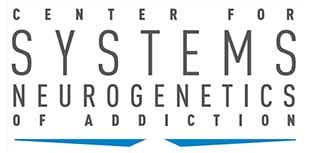Funded Projects
Dr. Vivek Kumar: Cocaine IVSA in Cyfip2 sensitization mutations
We will discover modifiers of the Cyfip2 gene function using the CC/CO founder strains.
The availability of 45 million novel genetic variants in the CC founders offers a unique opportunity to discover
novel modifiers of Cyfip2 deletion allele during the design of the Collaborative Cross, one of its
envisioned uses was to discover novel modifiers of knockouts, transgenes and induced mutations
(www.complextrait.org/Workshop1.pdf). We will create F1 hybrids between the 8 CC/DO fonder strains and
Cyfip2B6N/-. These progeny will be tested for locomotor sensitization and IVSA compared for genotype by
founder interaction in a factorial ANOVA. Any significant effect of founder would indicate the presence of a
modifier.
Dr. M. Imad Damaj: Nicotine reward behavioral variations and genetic heritability
To determine nicotine reward behavioral variations and genetic heritability in the 8 inbred DO founders after exposure to the drug in adolescence.
We will explore the genetic variance and behavioral variations in nicotine reward in the CPP test in early adolescent mice in 8 CC/DO founder lines (8 strains): five classical inbred strains (A/J, C57BL/6J, 129S1/SvImJ, NOD/ShiLtJ, and NZO/HlLtJ) and three wild-derived strains that were selected to represent three Mus musculus subspecies (CAST/EiJ, PWK/PhJ, and WSB/EiJ). Early adolescence period was chosen because it is the key developmental period for the initiation of smoking that progress on to dependence in later adolescence and young adulthood. We will also explore the hypothesis that exposure to nicotine in early adolescence will lead to an increase in cocaine reward in adulthood. More specifically, we estimate that the strength of nicotine reward in adolescent will correlate with cocaine behavioral sensitization in the CPP test when animals are tested later in adulthood.
Dr. Duygu Ucar: Interstrain Variability in Epigenetic Landscape in Response to Drug Exposure
We will utilize ATAC-seq in order to identify regions of open chromatin within the CC/DO progenitors, both naïve and cocaine treated. Using the current data generation and analysis pipeline for epigenetic biomarker discovery from open chromatin assays developed by our group at The Jackson Laboratory for Genomic Medicine, we will use striatum from mouse to generate ATAC-seq libraries. We will then integrate the epigenetic information together with phenotypic variation, genetic sequence variation and expression QTL. Using the RNA-seq data collected in the Integrative Genetics and Genomics Core from the other projects, together with gene sets produced from these studies, we will upload the gene sets to GeneWeaver, where they can be further integrated with published studies (GWAS, linkage, etc.), Gene Ontology Terms and Pathway commons data. With these analyses, we will identify the functional and system-level implications of differentially open chromatin sites between conditions. Moreover, integrating the ATAC-seq data with RNA-seq data due to the sequence variation of the founders will allow us to understand the effect of strain differences and drug exposure on chromatin and gene expression. We will also compare and integrate ocQTLs and eQTLs that have been associated with addiction to further dissect the role of genetics on chromatin and gene expression. The informatics analysis in GeneWeaver will allow us to compare results across species and identify overlap among our open chromatin and pathways of addiction.
Dr. Elliot Nelson: Construction and Validation of a Novel Mouse Model of Psychostimulant Dependence
We will create a ‘humanized’ TRIB3 mouse with both versions of the rs6115830 SNP (C/T) within the DNAase1/histone methylation region. Mouse and human TRIB3 are similar but not identical (74.6% and DNA 76.8% similarity), but to model changes at the level of SNPs it is essential that they be modeled in the context of the specific sequence that varies. Starting with the KOMP KO allele of Trib3 (Trib3tm1a(EUCOMM)Hmgu), bacterial artificial chromosome (BAC) transgenics will be created carrying the human genomic TRIB3 region. Once produced, 8 male and 8 female mice of each transgenic line will be phenotyped by the Behavioral Phenotyping Core.
